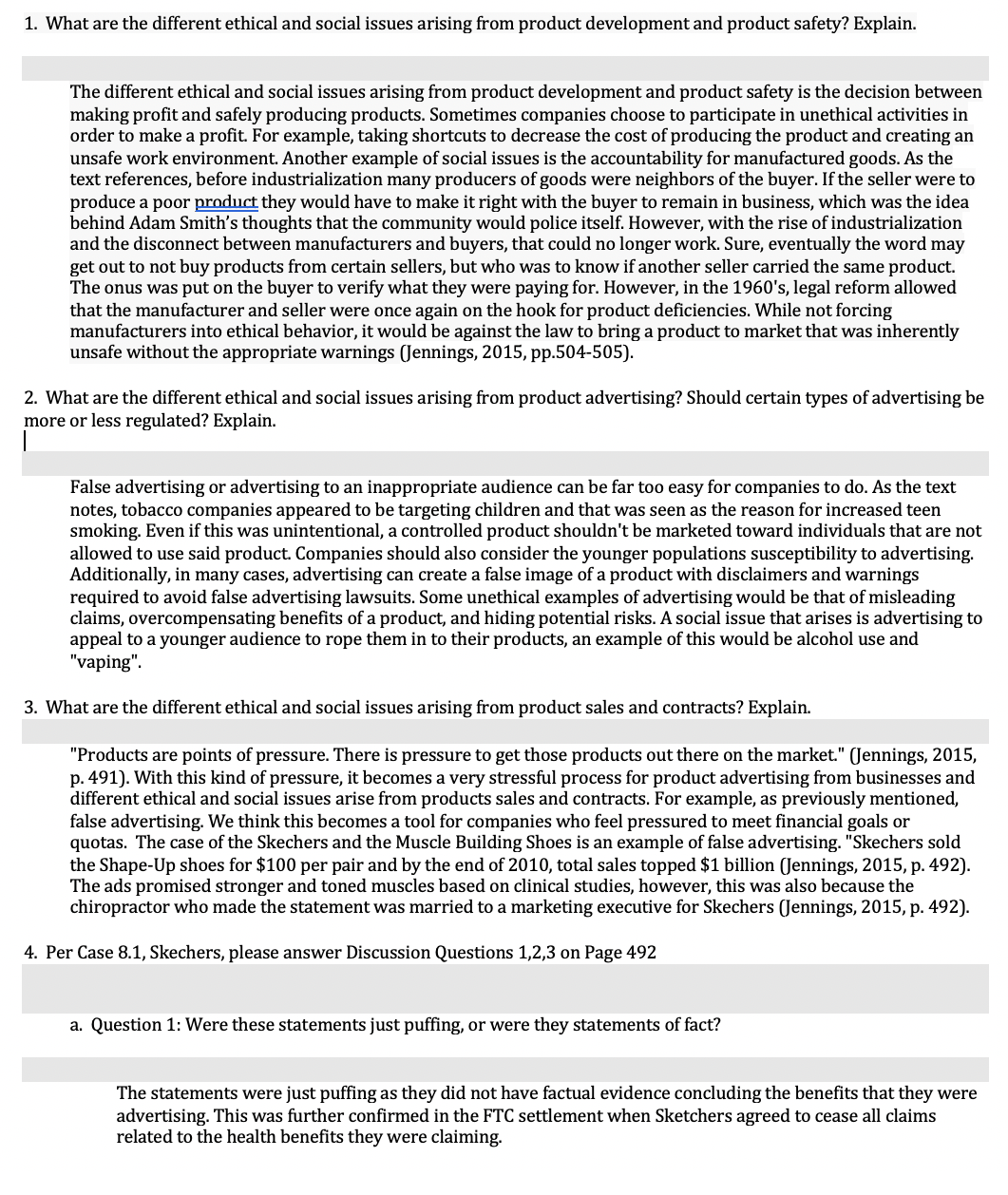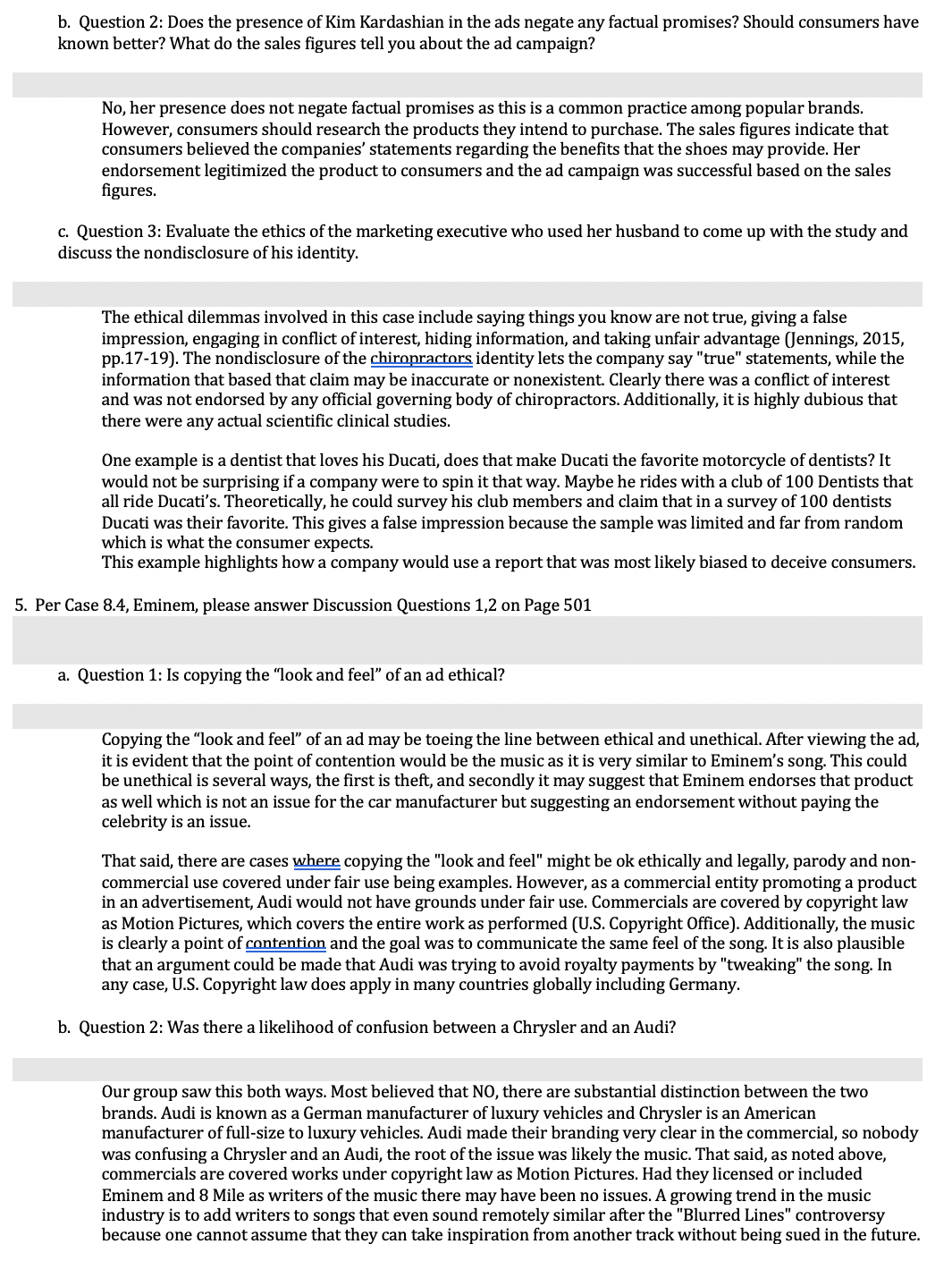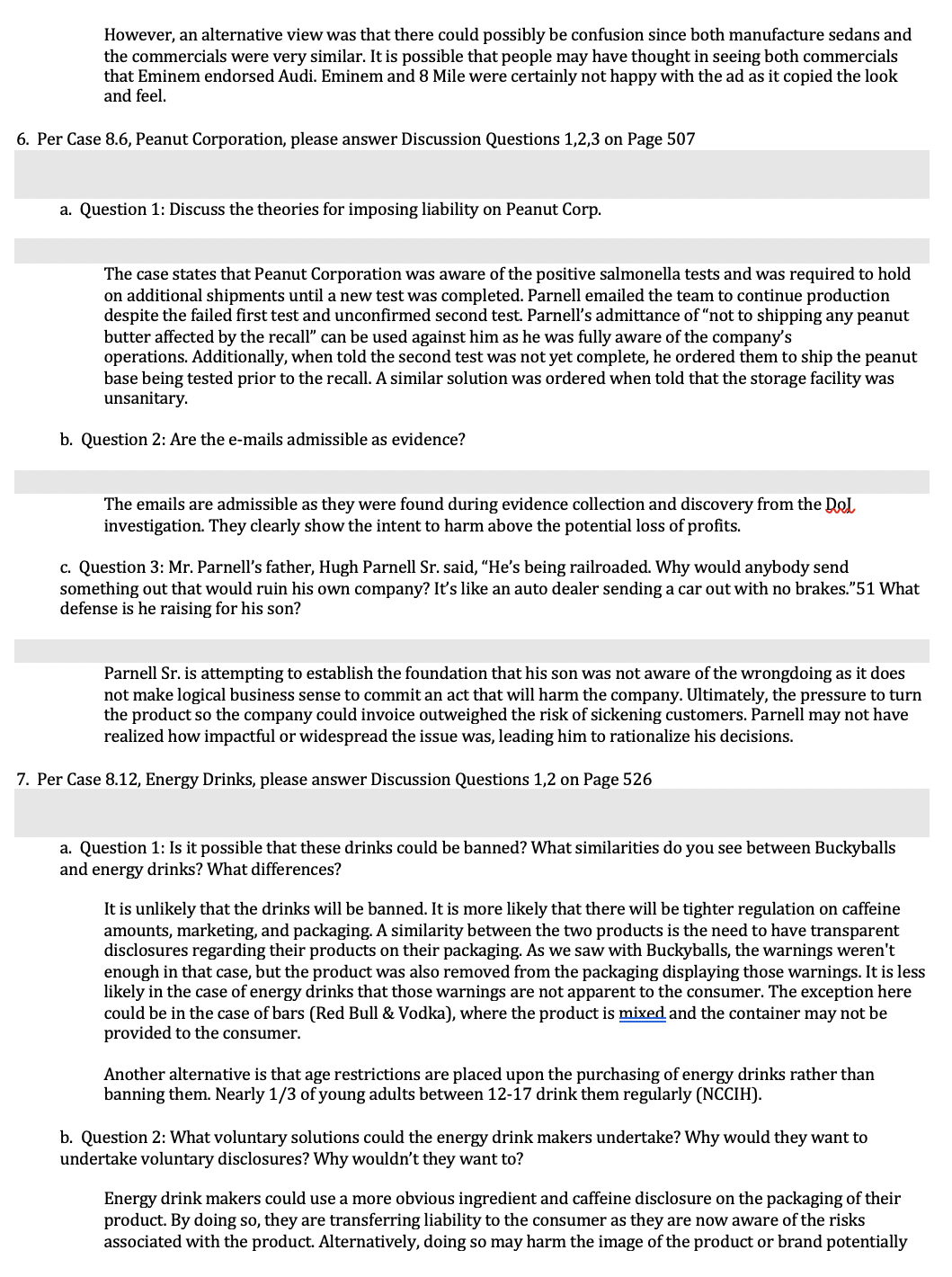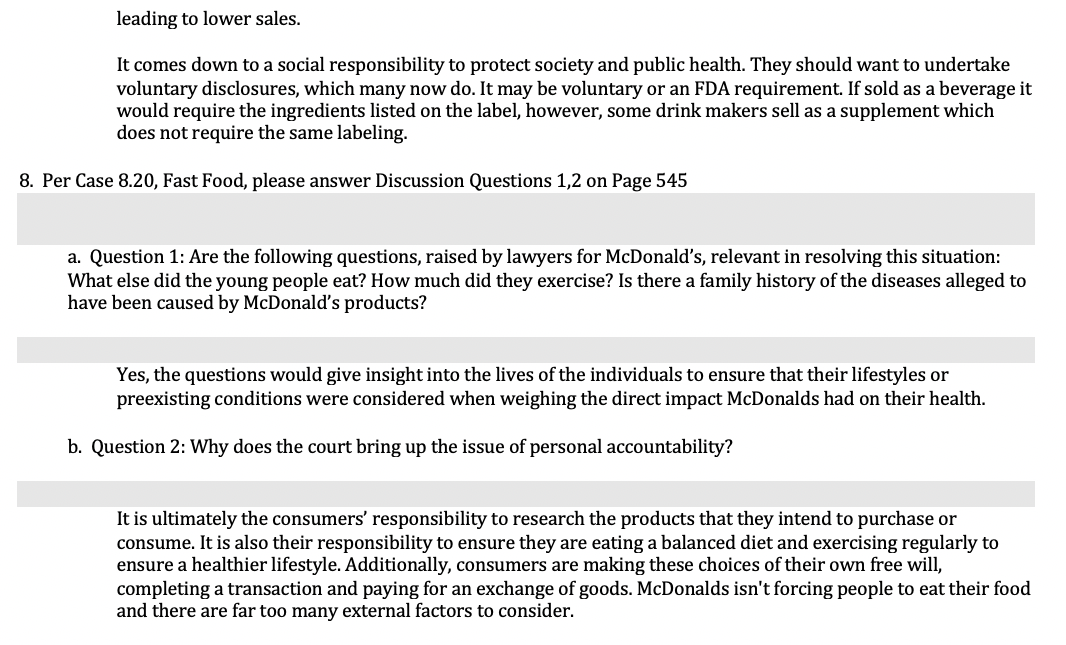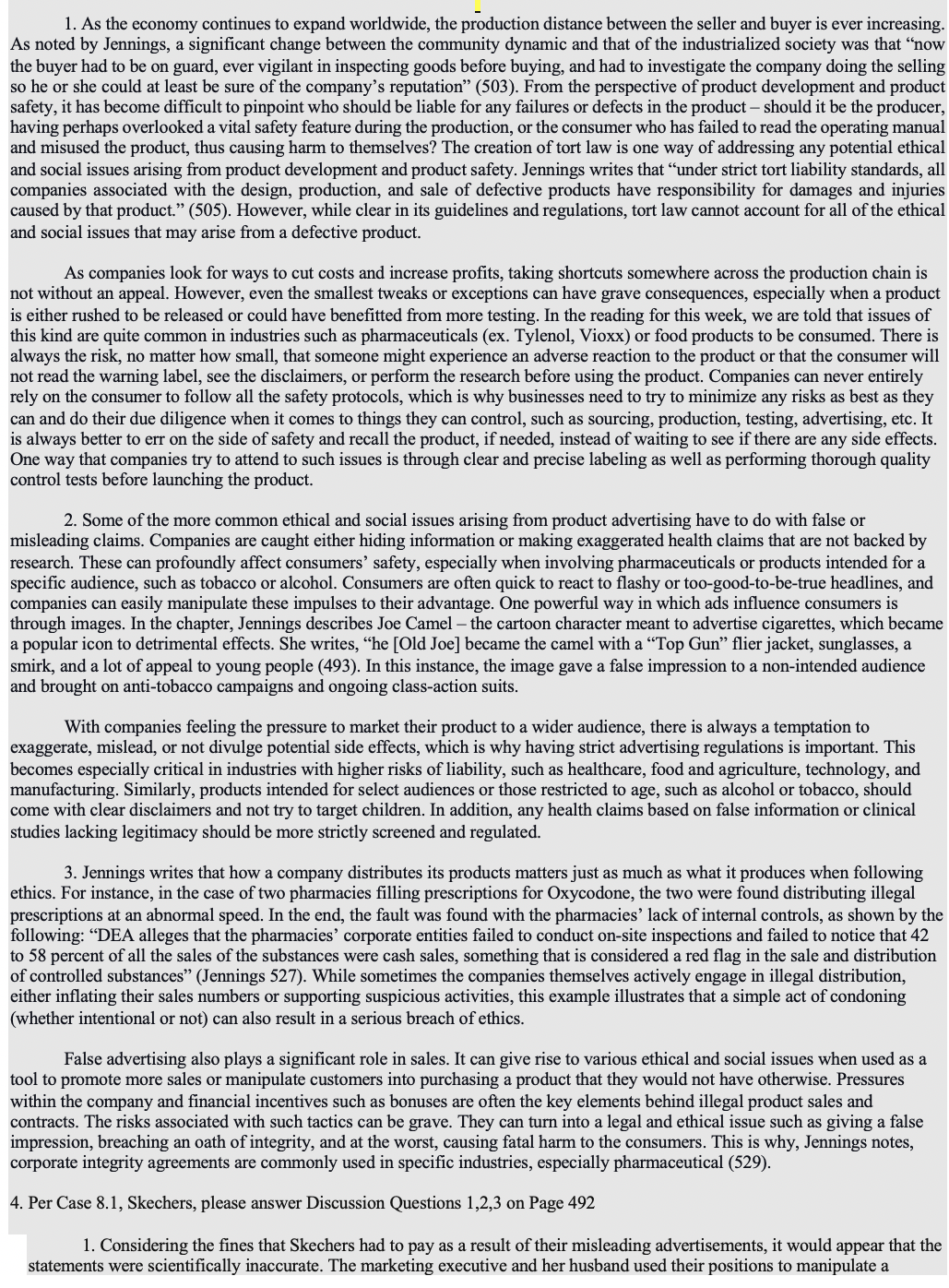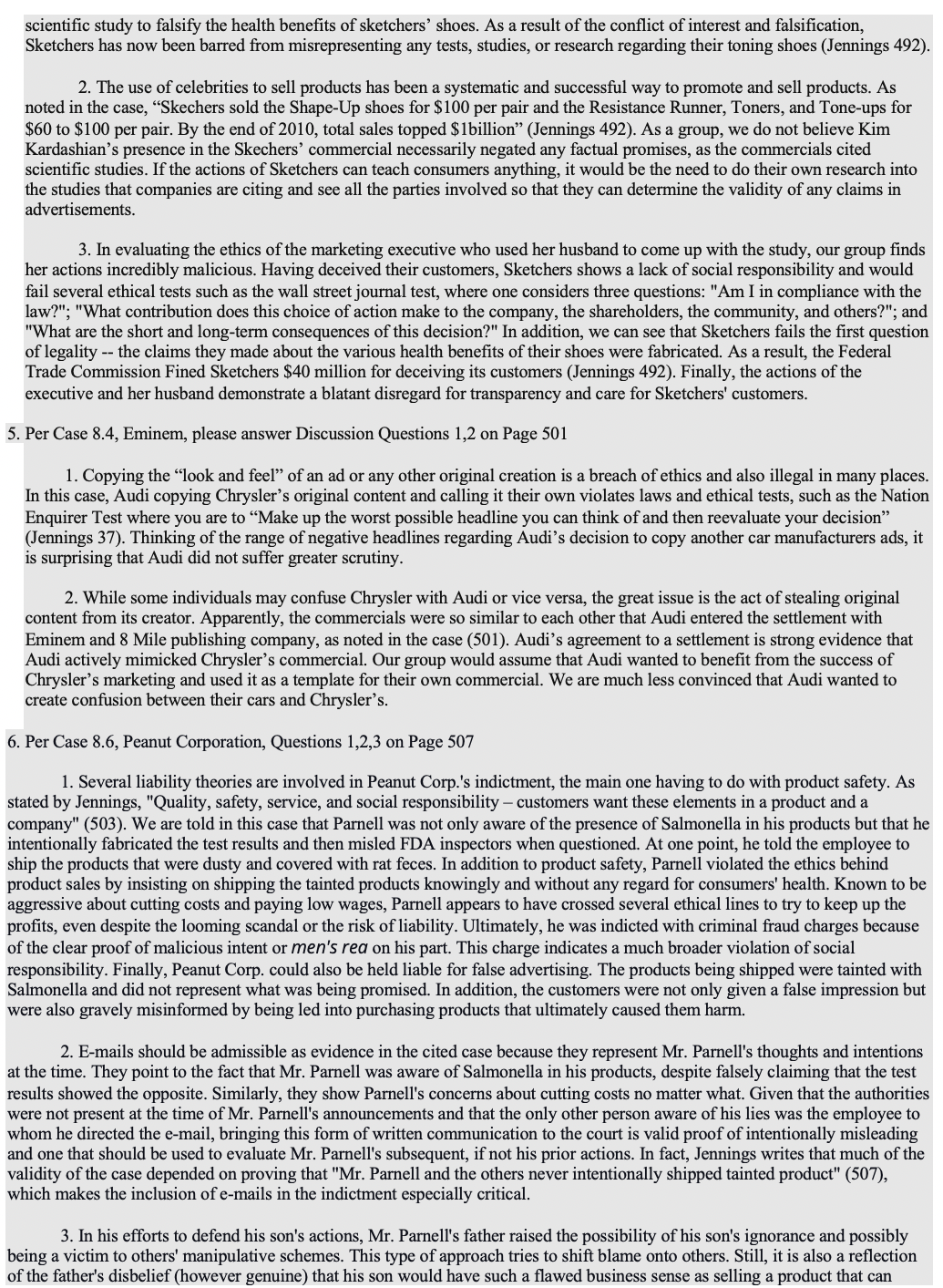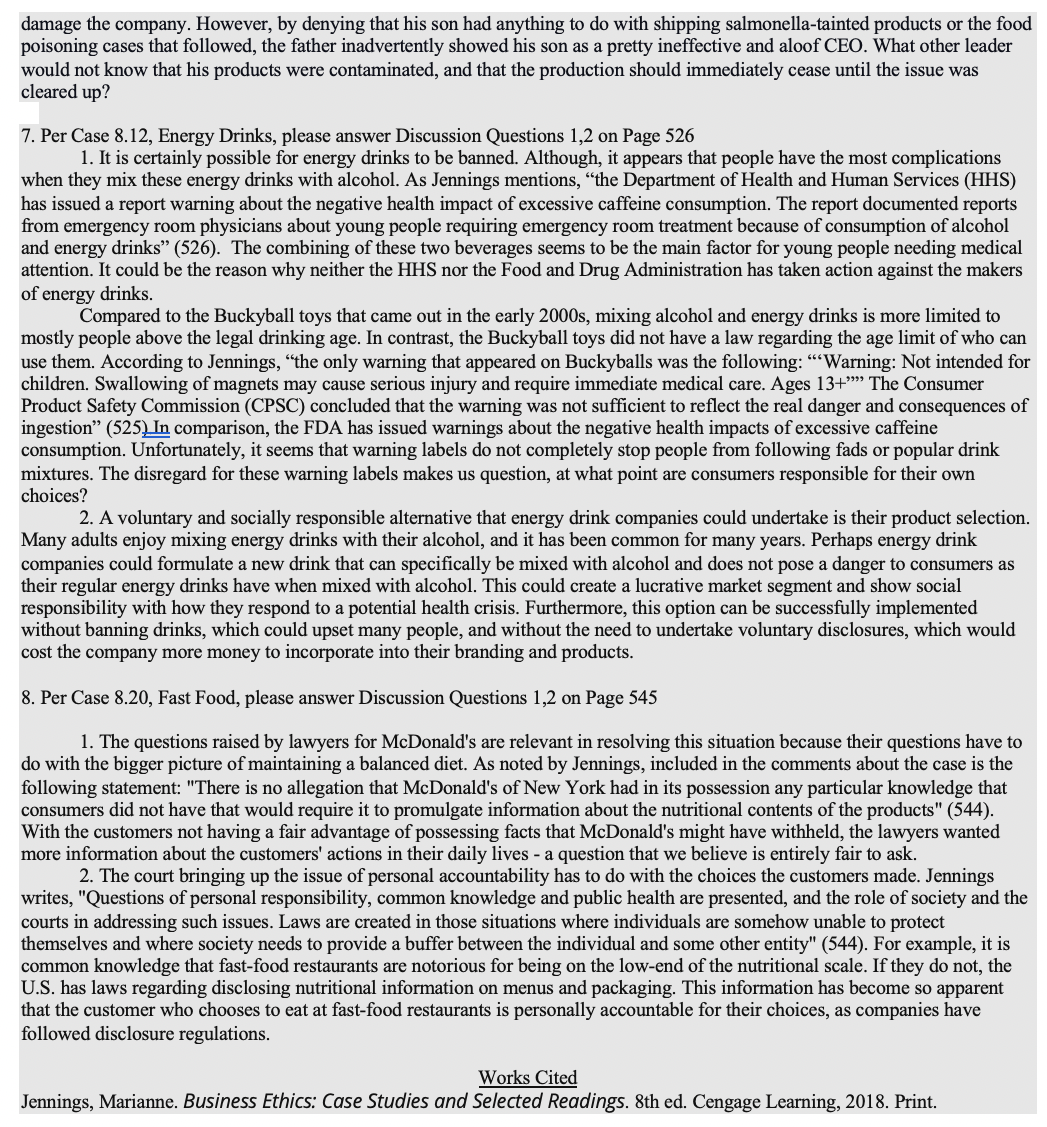Resspond to both texts either agreeing or disagreeing with their answers to the questions. No specific word count and resources are provided below.
SOURCES/MATERIAL
TEXT 1:
1. What are the different ethical and social issues arising from pro duct development and product safety? Explain. The different ethical and social issues arising from product development and product safety is the decision between making prot and safely producing products. Sometimes companies choose to participate in unethical activities in order to make a prot. For example, taking shortcuts to decrease the cost of producing the product and creating an unsafe work environment. Another example of social issues is the accountability for manufactured goods. As the text references, before industrialization many producers of go ads were neighbors of the buyer. If the seller were to produce a poor wthey would have to make it right with the buyer to remain in business, which was the idea behind Adam Smith's thoughts that the community would police itself. However, with the rise of industrialization and the disconnect between manufacturers and buyers, that could no longer work. Sure, eventually the word may get out to not buy products from certain sellers, but who was to know if another seller carried the same product. The onus was put on the buyer to verify what they were paying for. However, in the 1960's, legal reform allowed that the manufacturer and seller were once again on the hook for pro duct deciencies. While not forcing manufacturers into ethical behavior, it would be against the law to bring a product to market that was inherently unsafe without the appropriate warnings Uennings, 2015, pp.504505). 2. What are the different ethical and social issues arising 'om pro duct advertising? Should certain types of advertising be more or less regulated? Explain. False advertising or advertising to an inappropriate audience can be far too easy for companies to do. As the text notes, tobacco companies appeared to be targeting children and that was seen as the reason for increased teen smoking. Even if this was unintentional, a controlled product shouldn't be marketed toward individuals that are not allowed to use said product Companies should also consider the younger populations susceptibility to advertising. Additionally, in many cases, advertising can create a false image of a pro duct with disclaimers and warnings required to avoid false advertising lawsuits. Some unethical examples of advertising would be that of misleading claims, overco mpensating benets of a product, and hiding potential risks. A social issue that arises is advertising to appeal to a younger audience to rope them in to their products, an example of this would be alcohol use and "vaping". 3. What are the different ethical and social issues arising from pro duct sales and contracts? Explain. "Products are points of pressure. There is pressure to get those products out there on the market." U ennings, 2015, p. 491). With this kind of pressure, it becomes a very stressful process for product advertising 'om businesses and different ethical and social issues arise from products sales and contracts. For example, as previously mentioned, false advertising. We think this becomes a tool for companies who feel pressured to meet nancial goals or quotas. The case of the Skechers and the Muscle Building Shoes is an example of false advertising. "Skechers sold the Shape-Up shoes for $100 per pair and by the end of 2010, total sales topped $1 billion Uennings, 2015, p. 492). The ads promised stronger and toned muscles based on clinical studies, however, this was also because the chiropractor who made the statement was married to a marketing executive for Skechers (Jennings, 2015, p. 492). 4-. Per Case 8.1, Skechers, please answer Discussion Questions 1,2,3 on Page 492 a. Question 1: Were these statements just pufng, or were they statements of fact? The statements were just puffing as they did not have factual evidence concluding the benets that they were advertising. This was further conrmed in the FTC settlement when Sketchers agreed to cease all claims related to the health benets they were claiming. b. Question 2: Does the presence of Kim Kardashian in the ads negate any factual promises? Should consumers have known better? What do the sales gures tell you about the ad campaign? No, her presence does not negate factual promises as this is a common practice among popular brands. However, consumers should research the products they intend to purchase. The sales gures indicate that consumers believed the companies' statements regarding the benets that the shoes may provide. Her endorsement legitimized the product to consumers and the ad campaign was successful based on the sales gures. c. Question 3: Evaluate the ethics of the marketing executive who used her husband to co me up with the study and discuss the nondisclosure of his identity. The ethical dilemmas involved in this case include saying things you know are not true, giving a false impression, engaging in conflict of interest, hiding information, and taking unfair advantage Uennings, 20 15, pp.17-19). The nondisclosure of the imam identity lets the company say "true" statements, while the information that based that claim may be inaccurate or nonexistent Clearly there was a conict of interest and was not endorsed by any ofcial governing body of chiropractors. Additionally, it is highly dubious that there were any actual scientic clinical studies. One example is a dentist that loves his Ducati, does that make Ducati the favorite motorcycle of dentists? It would not be surprising if a company were to spin it that way. Maybe he rides with a club of 100 Dentists that all ride Ducati's. Theoretically, he could survey his club members and claim that in a survey of 100 dentists Ducati was their favorite. This gives a false impression because the sample was limited and far from random which is what the consumer expects. This example highlights how a company would use a report that was most likely biased to deceive consumers. 5. Per Case 8.4, Eminem, please answer Discussion Questions 1,2 on Page 501 a. Question 1: Is copying the "look and feel\" of an ad ethical? Copying the \"look and feel\" of an ad may be toeing the line between ethical and unethical. After viewing the ad, it is evident that the point of contention would be the music as it is very similar to Eminem's song. This could be unethical is several ways, the rst is theft, and secondly it may suggest that Eminem endorses that product as well which is not an issue for the car manufacturer but suggesting an endorsement without paying the celebrity is an issue. That said, there are cases where copying the "look and feel" might be ok ethically and legally, parody and non- commercial use covered under fair use being examples. However, as a commercial entity promoting a product in an advertisement, Audi would not have grounds under fair use. Commercials are covered by copyright law as Motion Pictures, which covers the entire work as performed [U.S. Copyright Ofce). Additionally, the music is clearly a point of contention and the goal was to communicate the same feel of the song. It is also plausible that an argument could be made that Audi was trying to avoid royalty payments by "tweaking" the song. In any case, US. Copyright law does apply in many countries globally including Germany. b. Question 2: Was there a likelihood of confusion between a Chrysler and an Audi? Our group saw this both ways. Most believed that NO, there are substantial distinction between the two brands. Audi is known as a German manufacturer of luxury vehicles and Chrysler is an American manufacturer of full-size to luxury vehicles. Audi made their branding very clear in the commercial, so nobody was confusing a Chrysler and an Audi, the root of the issue was likely the music. That said, as noted above, commercials are covered works under copyright law as Motion Pictures. Had they licensed or included Eminem and 3 Mile as writers of the music there may have been no issues. A growing trend in the music industry is to add writers to songs that even sound remotely similar aer the "Blurred Lines " controversy because one cannot assume that they can take inspiration from another track without being sued in the future. However, an alternative view was that there could possibly be confusion since both manufacture sedans and the commercials were very similar. It is possible that people may have thought in seeing both commercials that Eminem endorsed Audi. Eminem and 8 Mile were certainly not happy with the ad as it copied the look and feel. 6. Per Case 8.6, Peanut Corporation, please answer Discussion Questions 1,2,3 on Page 507 a. Question 1: Discuss the theories for imposing liability on Peanut Corp. The case states that Peanut Corporation was aware of the positive salmonella tests and was required to hold on additional shipments until a new test was completed. Parnell emailed the team to continue production despite the failed rst test and unconrmed second test. Pamell's admittance of "not to shipping any peanut butter affected by the recall\" can be used against him as he was fully aware of the company's operations. Additionally, when told the second test was not yet complete, he ordered them to ship the peanut base being tested prior to the recall. A similar solution was ordered when told that the storage facility was unsanitary. b. Question 2: Are the e-mails admissible as evidence? The emails are admissible as they were found during evidence collection and discovery from the 13531, investigation. They clearly show the intent to harm above the potential loss of prots. c. Question 3: Mr. Parnell's father, Hugh Parnell Sr. said, \"He's being railroaded. Why would anybody send something out that would ruin his own company? It's like an auto dealer sending a car out with no brakes.\"51 What defense is he raising for his son? Parnell Sr. is attempting to establish the foundation that his son was not aware of the wrongdoing as it does not make logical business sense to commitan act that will harm the company. Ultimately, the pressure to turn the product so the company could invoice outweighed the risk of sickening customers. Parnell may not have realized how impactful or widespread the issue was, leading him to rationalize his decisions. 7. Per Case 8.12, Energy Drinks, please answer Discussion Questions 1,2 on Page 526 a. Question 1: Is it possible that these drinks could be banned? What similarities do you see between Buckyballs and energy drinks? What differences? It is unlikely that the drinks will be banned. It is more likely that there will be tighter regulation on caffeine amounts, marketing, and packaging. A similarity between the two products is the need to have transparent disclosures regarding their products on their packaging. As we saw with Buckyballs, the warnings weren't enough in that case, but the product was also removed from the packaging displaying those warnings. It is less likely in the case of energy drinks that those warnings are not apparent to the consumer. The exception here could be in the case of bars [Red Bull 8; Vodka), where the product is mixed and the container may not be provided to the consumer. Another alternative is that age restrictions are placed upon the purchasing of energy drinks rather than banning them. Nearly 1/3 of young adults between 12-17 drink them regularly [NCClH]. b. Question 2: What voluntary solutions could the energy drink makers undertake? Why would they want to undertake voluntary disclosures? Why wouldn't they want to? Energy drink makers could use a mo re obvious ingredient and caffeine disclosure on the packaging of their product. By doing so, they are transferring liability to the consumer as they are now aware of the risks associated with the product. Alternatively, doing so may harm the image of the product or brand potentially leading to lower sales. It comes down to a social responsibility to protect society and public health. They should want to undertake voluntary disclosures, which many now do. It may be voluntary or an FDA requirement. If sold as a beverage it would require the ingredients listed on the label, however, some drink makers sell as a supplement which does not require the same labeling. 8. Per Case 8.20, Fast Food, please answer Discussion Questions 1,2 on Page 545 a. Question 1: Are the following questions, raised by lawyers for McDonald's, relevant in resolving this situation: What else did the young people eat? How much did they exercise? is there a family history of the diseases alleged to have been caused by McDonald's products? Yes, the questions would give insight into the lives of the individuals to ensure that their lifestyles or preexisting conditions were considered when weighing the direct impact McDonalds had on their health. b. Question 2: Why does the court bring up the issue of personal accountability? It is ultimately the consumers' responsibility to research the products that they intend to purchase or consume. It is also their responsibility to ensure they are eating a balanced diet and exercising regularly to ensure a healthier lifestyle. Additionally, consumers are making these choices of their own free will, completing a transaction and paying for an exchange of goods. McDonalds isn't forcing people to eat their food and there are far too many external factors to consider. 1. As the economy continues to expand worldwide, the production distance between the seller and buyer is ever increasing. As noted by Jennings, a signicant change between the community dynamic and that of the industrialized society was that \"now the buyer had to be on guard, ever vigilant in inspecting goods before buying, andhad to investigate the company doing the selling so he or she could at least be sure of the company's reputation" (503). From the perspective of product development and product safety, it has become difcult to pinpoint who should be liable for any failures or defects in the product should it be the producer, having perhaps overlooked a vital safety feature during the production, or the consumer who has failed to read the operating manual and misused the product, thus causing harm to themselves? The creation of tort law is one way of addressing any potential ethical and social issues arising from product development and product safety. Jennings writes that \"under strict tort liability standards, all companies associated with the design, production, and sale of defective products have responsibility for damages and injuries caused by that produc \" (505). However, while clear in its guidelines and regulations, tort law cannot account for all of the ethical and social issues that may arise from a defective product. As companies look for ways to cut costs and increase prots, taking shortcuts somewhere across the production chain is not without an appeal. However, even the smallest tweaks or exceptions can have grave consequences, especially when a product is either rushed to be released or could have benetted 'om more testing. In the reading for this week, we are told that issues of this kind are quite common in industries such as pharmaceuticals (ex. Tylenol, Vioxx) or food products to be consumed. There is always the risk, no matter how small, that someone might experience an adverse reaction to the product or that the consumer will not read the warning label, see the disclaimers, or perform the research before using the product. Companies can never entirely rely on the consumer to follow all the safety protocols, which is why businesses need to try to minimize any risks as best as they can and do their due diligence when it comes to things they can control, such as sourcing, production, testing, advertising, etc. It is always better to err on the side of safety and recall the product, if needed, instead of waiting to see if there are any side effects. One way that companies try to attend to such issues is thrOugh clear and precise labeling as well as performing thorough quality control tests before launching the product. 2. Some of the more common ethical and social issues arising om product advertising have to do with false or misleading claims. Companies are caught either hirng information or making exaggerated health claims that are not backed by research. These can profoundly affect consumers' safety, especially when involving pharmaceuticals or products intended for a specic audience, such as tobacco or alcohol. Consumers are oen quick to react to ashy or too-good-to-be-true headlines, and companies can easily manipulate these impulses to their advantage. One powerful way in which ads inuence consumers is through images. In the chapter, Jennings describes Joe Camel the cartoon character meant to advertise cigarettes, which became a popular icon to detrimental effects. She writes, \"he [Old Joe] became the camel with a \"Top Gun\" ier jacket, sunglasses, a smirk, and a lot of appeal to young people (493). In this instance, the image gave a false impression to a non-intended audience and brought on anti-tobacco campaigns and ongoing class-action suits. With companies feeling the pressure to market their product to a wider audience, there is always a temptation to exaggerate, mislead, or not divulge potential side effects, which is why having strict advertising regulations is important. This becomes especially critical in industries with higher risks of liability, such as healthcare, food and agriculture, technology, and manufacturing. Similarly, products intended for select audiences or those restricted to age, such as alcohol or tobacco, should come with clear disclaimers and not try to target children. In addition, any health claims based on false information or clinical studies lacking legitimacy should be more strictly screened and regulated 3. Jennings writes that how a company distributes its products matters just as much as what it produces when following ethics. For instance, in the case of two pharmacies lling prescriptions for Oxycodone, the two were found distributing illegal prescriptions at an abnormal speed. In the end, the fault was found with the pharmacies' lack of internal controls, as shown by the following: \"DEA alleges that the pharmacies' corporate entities failed to conduct on-site inspections and failed to notice that 42 to 58 percent of all the sales of the substances were cash sales, something that is considered a red ag in the sale and distribution of controlled substances\" (Jennings 527). While sometimes the companies themselves actively engage in illegal distribution, either inating their sales numbers or supporting suspicious activities, this example illustrates that a simple act of condoning (whether intentional or not) can also result in a serious breach of ethics. False advertising also plays a signicant role in sales. It can give rise to various ethical and social isSues when used as a tool to promote more sales or manipulate customers into purchasing a product that they would not have otherwise. Pressures within the company and nancial incentives such as bonuses are often the key elements behind illegal product sales and contracts. The risks associated with such tactics can be grave. They can turn into a legal and ethical issue such as giving a false impression, breaching an oath of integrity, and at the worst, causing fatal harm to the consumers. This is why, Jennings notes, corporate integrity agreements are commonly used in specic industries, especially pharmaceutical (529). 4. Per Case 8.1, Skechers, please answer Discussion Questions 1,2,3 on Page 492 1. Considering the lines that Skechers had to pay as a result of their misleading advertisements, it would appear that the statements were scientically inaccurate. The marketing executive and her husband used their positions to manipulate a scientic study to falsify the health benets of sketchers' shoes. As a result of the conict of interest and falsication, Sketchers has now been barred 'om misrepresenting any tests, studies, or research regarding their toning shoes (Jennings 492). 2. The use of celebrities to sell products has been a systematic and successful way to promote and sell products. As noted in the case, \"Skechers sold the Shape-Up shoes for $100 per pair and the Resistance Runner, Toners, and Tone-ups for $60 to $100 per pair. By the end of 2010, total sales topped $lbillion\" (Jennings 492). As a group, we do not believe Kim Kardashian's presence in the Skechers' commercial necessarily negated any factual promises, as the commercials cited scientic studies. If the actions of Sketchers can teach consumers anything, it would be the need to do their own research into the studies that companies are citing and see all the parties involved so that they can determine the validity of any claims in advertisements. 3. In evaluating the ethics of the marketing executive who used her husband to come up with the study, our group nds her actions incredibly malicious. Having deceived their customers, Sketchers shows a lack of social responsibility and would il several ethical tests such as the wall street journal test, where one considers three questions: "Am I in compliance with the law?"; "What contribution does this choice of action make to the company, the shareholders, the community, and others?"; and "What are the short and long-term consequences of this decision." In addition, we can see that Sketchers fails the rst question of legality - the claims they made abOut the various health benets of their shoes were fabricated. As a result, the Federal Trade Commission Fined Sketchers $40 million for deceiving its customers (Jennings 492). Finally, the actions of the executive and her husband demonstrate a blatant disregard for transparency and care for Sketchers' customers. 5. Per Case 8.4, Eminent, please answer Discussion Questions 1,2 on Page 501 1. Copying the \"look and feel\" of an ad or any other original creation is a breach of ethics and also illegal in many places. In this case, Audi copying Chrysler's original content and calling it their own violates laws and ethical tests, such as the Nation Enquirer Test where you are to \"Make up the worst possible headline you can think of and then reevaluate your decision" (Jennings 37). Thinking of the range of negative headlines regarding Audi's decision to copy another car manufacturers ads, it is surprising that Audi did not suffer greater scrutiny. 2. While some individuals may conise Chrysler with Audi or vice versa, the great issue is the act of stealing original content om its creator. Apparently, the commercials were so similar to each other that Audi entered the settlement with Eminem and 8 Mile publishing company, as noted in the case (501). Audi's agreement to a settlement is strong evidence that Audi actively mimicked Chrysler's commercial. Our group would assume that Audi wanted to benet from the success of Chrysler's marketing and used it as a template for their own commercial. We are much less convinced that Audi wanted to create contsion between their cars and Chrysler's. 6. Per Case 8.6, Peanut Corporation, Questions 1,2,3 on Page 507 1. Several liability theories are involved in Peanut Corp.'s indictment, the main one having to do with product safety. As stated by Jennings, "Quality, safety, service, and social responsibility customers want these elements in a product and a companf' (503). We are told in this case that Parnell was not only aware of the presence of Salmonella in his products but that he intentionally fabricated the test results and then misled FDA inspectors when questioned. At one point, he told the employee to ship the products that were dusty and covered with rat feces. In addition to product safety, Parnell violated the ethics behind product sales by insisting on shipping the tainted products knowingly and without any regard for consumers' health. Known to be aggressive about cutting costs and paying low wages, Parnell appears to have crossed several ethical lines to try to keep up the prots, even despite the looming scandal or the risk of liability. Ultimately, he was indicted with criminal aud charges because of the clear proof of malicious intent or men's red on his part. This charge indicates a much broader violation of social responsibility. Finally, Peanut Corp. could also be held liable for false advertising. The products being shipped were tainted with Salmonella and did not represent what was being promised. In addition, the customers were not only given a false impression but were also gravely misinformed by being led into purchasing products that ultimately caused them harm. 2. E-mails should be admissible as evidence in the cited case because they represent Mr. Parnell's thoughts and intentions at the time. They point to the fact that Mr. Parnell was aware of Salmonella in his products, despite falsely claiming that the test results showed the opposite. Similarly, they show Parnell's concerns about cutting costs no matter what. Given that the authorities were not present at the time of Mr. Parnell's announcements and that the only other person aware of his lies was the employee to whom he directed the e-mail, bringing this form of written communication to the court is valid proof of intentionally misleading and one that should be used to evaluate Mr. Parnell's subsequent, if not his prior actions. In fact, Jennings writes that much of the validity of the case depended on proving that "Mr. Parnell and the others never intentionally shipped tainted product" (507), which makes the inclusion of e-mails in the indictment especially critical. 3. In his efforts to defend his son's actions, Mr. Parnell's father raised the possibility of his son's ignorance and possibly being a victim to others' manipulative schemes. This type of approach tries to shift blame onto others. Still, it is also a reection of the father's disbelief (however genuine) that his son would have such a awed business sense as selling a product that can damage the company. However, by denying that his son had anything to do with shipping salmonella-tainted products or the food poisoning cases that followed, the father inadvertently showed his son as a pretty ineffective and aloof CEO. What other leader would not know that his products were contaminated, and that the production should immediately cease until the issue was cleared up? 7. Per Case 8.12, Energy Drinks, please answer Discussion Questions 1,2 on Page 526 1. It is certame possible for energy drinks to be banned. Although, it appears that people have the most complications when they mix these energy drinks with alcohol. As Jennings mentions, \"the Department of Health and Human Services (HHS) has issued a report warning about the negative health impact of excessive caffeine consumption. The report documented reports -om emergency room physicians about young people requiring emergency room treatment because of consumption of alcohol and energy drinks\" (526). The combining of these two beverages seems to be the main factor for young people needing medical attention. It could be the reason why neither the HHS nor the Food and Drug Administration has taken action against the makers of energy drinks. Compared to the Buckyball toys that came out in the early 2000s, mixing alcohol and energy drinks is more limited to mostly people above the legal drinking age. In contrast, the Buckyball toys did not have a law regarding the age limit of who can use them. According to Jennings, \"the only warning that appeared on Buckyballs was the following: \"Warning: Not intended for children. Swallowing of magnets may cause serious injury and require immediate medical care. Ages 13+'\"' The Consumer Product Safety Commission (CPSC) concluded that the warning was not sufcient to reect the real danger and consequences of ingestion\" (525g comparison, the FDA has issued warnings about the negative health impacts of excessive caffeine consumption. Unfortunately, it seems that warning labels do not completely stop people from following fads or popular drink mixtures. The disregard for these warning labels makes us question, at what point are consumers responsible for their own choices? 2. Avoluntary and socially responsible alternative that energy drink companies could undertake is their product selection. May adults enjoy mixing energy drinks with their alcohol, and it has been common for many years. Perhaps energy drink companies could formulate a new drink that can specically be mixed with alcohol and does not pose a danger to consumers as their regular energy drinks have when mixed with alcohol. This could create a lucrative market segment and show social responsibility with how they respond to a potential health crisis. Furthermore, this option can be successfully implemented without banning drinks, which could upset many people, and without the need to undertake voluntary disclosures, which would cost the company more money to incorporate into their branding and products. 8. Per Case 8.20, Fast Food, please answer Discussion Questions 1,2 on Page 545 l. The questions raised by lawyers for McDonald's are relevant in resolving this situation because their questions have to do with the bigger picture of maintaining a balanced diet. As noted by Jennings, included in the comments about the case is the following statement "There is no allegation that McDonald's of New York had in its possession any particular knowledge that consumers did not have that would require it to promulgate information about the nutritional contents of the products" (544). With the customers not having a fair advantage of possessing facts that McDonald's might have withheld the lawyers wanted more information about the customers' actions in their daily lives - a question that we believe is entirely fair to ask. 2. The court bringing up the issue of personal accountability has to do with the choices the customers made. Jennings writes, "Questions of personal responsibility, common knowledge and public health are presented, and the role of society and the courts in addressing such issues. Laws are created in those situations where individuals are somehow unable to protect themselves and where society needs to provide a buffer between the individual and some other entity" (544). For example, it is common knowledge that fast-food restaurants are notorious for being on the low-end of the nutritional scale. If they do not, the U.S. has laws regarding disclosing nutritional information on menus and packaging. This information has become so apparent that the customer who chooses to eat at fast-food restaurants is personally accountable for their choices, as companies have followed disclosure regulations. Works Cited Jennings, Marianne. Business Ethics: Case Studies and Selected Readings. 8th ed. Cengage Learning, 2018. Print
